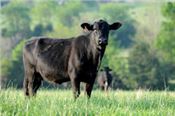Grass To Grid Program Helps Cow-Calf Operations Access Feedlot Benefits, Data

The Grass to Grid program allows participating producers a chance to send a small number of steers and heifers to an out-of-state feedlot, where they will be grain- finished on high-nutrient feed before processing. Once the animals are slaughtered, the producers will receive data on the beef to help them understand how breeding choices on the farm bear out in the final product.
Division of Agriculture photo
RYAN MCGEENEY
LITTLE ROCK, ARKANSAS
The University of Arkansas System Division of Agriculture is offering Arkansas cattle producers – particularly those running smaller cow- calf operations – the opportunity to gain insight into herd genetics through participation in large finishing operations.
The Grass to Grid program allows participating producers a chance to send a small number of steers and heifers to an out-of-state feedlot, where they will be grain-finished on high-nutrient feed before processing. Once the animals are slaughtered, the producers will receive data on the beef to help them understand how breeding choices on the farm bear out in the final product.
Shane Gadberry, professor of ruminant nutrition for the Division of Agriculture, said that the beef industry in the United States is so segmented that smaller cow-calf operators often never have the opportunity to see how their products fare against those from other operations.
“It’s an educational opportunity for Arkansas cow-calf producers to see how the genetics of their calves stack up,” Gadberry said. “Do they grade USDA Choice that’s on the familiar label at the grocery store, or does the quality of beef differ from what consumers are used to purchasing?
“Producers can use that data to make management changes to their herd,” he said. “That may mean buying a new bull.”
Interested producers can learn more about the program and register at https://www.uaex.uada.edu/farm-ranch/animals-forages/beef-cattle/grass-to-grid.aspx . The deadline for registering for the program is March 1, 2022. There is a $5 per head fee, which covers ear tagging and other operational costs. Participants must enroll a minimum of five mixed-sex or three same-sex calves, and calves must weigh between 500-800 lbs. There is no maximum entry.
While Arkansas has many cow-calf producers, Gadberry said, there are virtually no feedlots in the state. The Division of Agriculture ran a previous version of the Grass to Grid program until 2014. Gadberry said the program is being revamped in response to interest from a new generation of Arkansas cow-calf producers. ∆
Contents provided by University of Arkansas